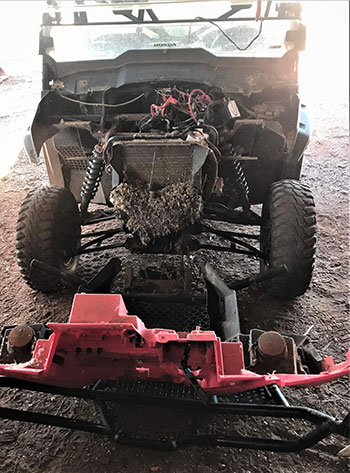Comprehensive on-farm vehicle and machinery hygiene is crucial to prevent the spread of hitchhiker pests, diseases and weeds that could potentially devastate Australian agriculture.
The impact of pests varies across species, but it is estimated to contribute to a yield gap of 20 to 40 per cent in grain crops each year. Weeds alone are estimated to impose an overall average cost of $5 billion a year in Australia, with chemical control and production loss making up most of this.
Pests can reduce farm enterprise profits through direct production loss, additional costs of control measures and damage mitigation as well as through export market losses.
One of the first lines of defence in preventing biosecurity threats from entering and spreading on-farm is washing down all vehicles and machinery, including those belonging to visitors and contractors.
“Cleaning machinery and vehicles before they enter production areas will substantially reduce the risk of introducing new pests,” says Plant Health Australia (PHA) national manager of preparedness and research, development and extension Stuart Kearns.
Mr Kearns says vehicle hygiene is an integral part of effective farm biosecurity that is often overlooked. “A vehicle washdown area is a worthwhile investment for a farm business. While this may seem too expensive and inconvenient at first, a simple washdown area can save significant management costs.”
A vehicle washdown area can be customised to suit any property’s requirements. If the property is leased or the business is potentially expanding or moving, a portable washdown system might be easier to set up than a permanent one.
Vehicle washdown areas do not have to be state of the art and expensive; they just need to be fit for purpose.
Key things to consider:
- locate in an open area, close to the property’s entry and exit points so that it is easy to use;
- provide clear instructions and signs for use;
- locate away from production areas, crops and livestock;
- ensure it is big enough for machinery such as tractors and headers;
- access to high-pressure water and air, as well as power for cleaning;
- high-pressure water should also be low-volume to reduce the volume of water used per vehicle and to mitigate the risk of overspray;
- washdown surface should be concrete, bitumen, ballast rock or compacted gravel;
- run-off should be directed away from paddocks, livestock and other water sources; and
- availability of sump or wastewater collection area for water, dirt and plant material that can be checked and treated for pests, weeds and contaminants.
Additional ways to manage biosecurity threats on-farm:
- Farm zoning can reduce the need for washing all vehicles that enter a property. By zoning a farm into biosecurity areas, it is easier to determine which vehicles entering a particular zone on the property need to be cleaned.
- Having a designated area for visitor parking away from production areas allows people such as family or visitors to enter without having to wash vehicles.
- Visitors and workers can make use of designated farm vehicles to enter production areas.
- Keeping a record of people and vehicle movement in and out of the property is also recommended to allow tracing of people and machinery in the event of pest or disease establishment.
- Limiting entry points to the property.
- Having a farm biosecurity sign to inform visitors of on-farm biosecurity requirements.
When washing large machinery, safety guards and access panels might need to be removed as much as possible to provide access to hard-to-reach areas, which may have plant matter or insects attached.
 Plant material can accumulate in machinery, so it should be dismantled as much as possible. Photo: J. Kirk
Plant material can accumulate in machinery, so it should be dismantled as much as possible. Photo: J. Kirk
All parts of farm vehicles – including tyres, wheel arches, undercarriages, underneath windscreen wipers, grilles, floors and trays – need to be washed thoroughly to remove pests or infected material.
Cleaning should be done from the top of the vehicle, working towards the ground. Compressed air can be used for parts of the vehicle that do not allow water – for example, areas that house electrical components.
In high-risk situations, a decontaminant solution can also be applied to all surfaces that have been in contact with mud and dirt including footwear, tools, floor mats and foot pedals, and then rinsed off (always read chemical labels before use). This will reduce the chance of risks such as viruses, bacteria and fungal spores being spread. The washdown area should also be cleaned down after use, ready for the next vehicle.
The Grains Farm Biosecurity Program (GFBP) has developed a fact sheet on effective farm washdown facilities, as well as a vehicle biosecurity risk assessment tool to determine whether a vehicle requires cleaning before entering a property.
The GFBP is an initiative of PHA, Grain Producers Australia, and the New South Wales, Queensland, South Australian, Victorian and Western Australian governments to improve the management of, and preparedness for, biosecurity risks in the grains industry at farm and industry levels.

























































